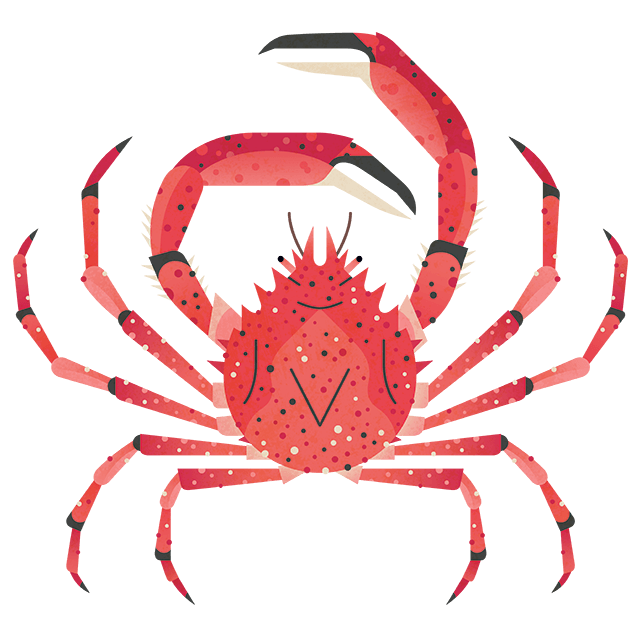
24 marine animals found in UK seas
12 minute read
The UK's seas are full of rich wildlife who call our British coast their home. From the large basking shark to the tiny bobtail squid, discover our list of 24 marine animals that can be found in our ocean below.
Leatherback turtle

Credit: ACEgan via Shutterstock
- Leatherback turtles are the largest species of marine turtle, usually growing to around 2 metres long
- Leatherbacks get their name from their black, leathery shell and are unique among reptiles in that they can metabolically raise their body temperature above that of their surrounding environment, allowing them to survive in colder waters
- Leatherback turtles are critically endangered, and climate change is their biggest threat. The temperature of turtle eggs during incubation determines the sex of hatchling turtles, so if global surface temperatures increase, it could feminize turtle populations, making male turtles very scarce. Climate change also threatens to destroy reef and seagrass ecosystems - which turtles depend on.
- Leatherbacks are the most common turtle species in the UK. In the summer, they come to UK waters to feed on jellyfish
Find out more about turtles in our Q&A with Dr Peter Richardson, expert in ocean conservation.
Basking shark

Credit: Martin Prochazkacz via Shutterstock
- Basking sharks can reach lengths of up to 12 metres and are second in size only to the gigantic whale shark
- Their huge mouths can be up to a metre wide but these gentle giants are filter feeders, meaning they mostly dine on plankton
- The basking shark is a seasonal visitor to the UK – the best time to spot one is between May and October, when a significant number of them arrive in British waters
Learn how we campaigned for a world-first protected area for basking sharks and other species in the Sea of Hebrides.
Seahorses

Credit: Georgie Bull
- There are two species around the British coastline, the Spiny Seahorse (Hippocampus guttulatus) and the Short Snouted Seahorse (Hippocampus hippocampus)
- Spiny seahorses can change colour to match their environment
- The male seahorse fertilises and looks after the eggs in a pouch
- Seahorses eat small crustacea. An adult eats 30-50 times a day while seahorse fry (baby seahorses) eat an incredible 3,000 pieces of food per day
Find out more about how our seagrass recovery projects aim to protect and recover these vital habitats.
Curled octopus

Credit: Kirsty Andrews
- These guys grow up to 50cm and are found all around the UK and Irish coast
- They get their name from the fact that when they’re sitting at rest they curl up the end of their tentacles
- They have a single row of suckers on their tentacles (the Common Octopus has two rows)
Discover more fascinating fact about octopuses.
Cuttlefish

Credit: Cathy Lewis
- Cuttlefish aren’t actually fish, they’re cephalopods related to squid and octopus
- Despite being colorblind, cuttlefish have highly sophisticated color-changing abilities which they use to camouflage themselves
- They have one of the biggest brain to body ratios and are intelligent enough to count
Discover how our seagrass rewilding project in Plymouth has helped cuttlefish in the surrounding area.
Hermit crab

Credit: Kirsty Andrews
- Hermit crabs make their home inside of empty discarded shells. They molt their exoskeleton to grow and as they grow they ‘upgrade’ to bigger and bigger shells.
- Hermit crabs aren’t actually hermits. They dislike solitude and can live in colonies up to 100 or more
Find out more about crabs in our Q&A with crab expert, Peter Davie.
Common sunstar

Credit: Cathy Lewis
- Sunstars are a type of starfish. They have 9-12 arms which look like sunrays – hence the name. If they lose one of their limbs, it can regenerate
- Sunstars have a voracious appetite and will even eat each other
- They have no brain and no blood.
Orca

Credit: Petr Slezak via Shutterstock
- Despite also being known as Killer Whales, they aren’t actually whales, they’re the largest species in the dolphin family
- They can live for up to 90 years and are one of the most widespread animals on the planet
- Orcas communicate through a range of whistles, squeals, clicks, squeaks and screams and they have distinct ‘languages’ within their family groups.
Northern gannet

Credit: Giedriius Shutterstock
- The Northern Gannet has a whopping wingspan up to 2m making them one of the UK’s largest seabirds
- 220,000 pairs of gannets nest around our coasts - that's 60-70% of the world's gannet population
- Bass Rock in Scotland is the world’s largest colony of Northern Gannets (around 150,000)
- Gannets dive from heights of 30 metres, hitting the water at speeds of up to 60mph!
- Gannet is the UK's largest breeding seabird (black-browed albatross occasionally visit but don't breed here).
Bobtail squid

Credit: optionm Shutterstock
- Bobtail squid are a group of cephalopods related to cuttlefish but they have a rounder mantle and no cuttlebone
- They’re nicknamed “dumpling squid” because they look like dumplings and are about the size of a thumb
- They use bioluminescent glowing bacteria within their bodies to camouflage themselves by mimicking the moonlight at night and stay concealed in the sand during the day.
Barrel jellyfish

Credit: Cathy Lewis
- Barrel jellyfish are sometimes called ‘dustbin lid jellyfish’ due to their large size – they can grow up to one metre in diameter!
- They have a solid, spherical, rubbery-looking bell which can be white, pale pink, blue or yellow
- Rather than thin tentacles, Barrels have eight thick, frilled arms – hence its former scientific name ‘Rhizostoma octopus’ (now Rhizostoma pulmo).
Learn more facts about these fascinating creatures.
Oysters

Credit: Maverick Photo Agency
- Common or Native oysters live on the seabed in shallow coastal waters and estuaries. They usually live in waters up to 30 metres in depth but have been found to survive in deeper waters (up to 80 metres)
- Typically, native oysters live for between five to ten years, but can be found to live up to 30 years of age.
- As oysters grow, they form rock-like reefs that provide vital habitats for other marine life
- A single oyster can filter 200 litres of water every day, and purifies it by doing so, removing pollutants, chemicals and particulates
- Wild native oyster beds are one of the most endangered marine habitats in Europe, and their population in the UK has decreased by 95%, largely due to historic over-harvesting.
Discover more about the importance of this species in our Oyster recovery project.
Blue shark

Credit: Kirsty Andrews
- Blue sharks are highly migratory – each year they make huge trans-Atlantic migrations and are one of the few species that travel in a ‘school’ or larger group
- They visit UK waters in the summer
- Sharks are at the top of the food chain in virtually every location they’re found. Their presence indicates a healthy marine ecosystem
- There is often a hierarchy in these schools of blue sharks, and they can be segregated by size or sex. Sometimes, groups of all females or all males pair up in a school
- Smaller blue sharks are sometimes prey for other larger sharks like the great white or tiger shark.
Read more about our work in Anguilla to improve awareness and understanding of sharks.
Sunfish

Credit: Gonzalo Jara via Shutterstock
- Sunfish are the heaviest bony fish in the world - they can weigh up to 5,000 pounds and grow over 10 feet long
- They get their name from lying at the surface of the water where they absorb heat from sunlight
- They have no tail or tail fin but they are surprisingly fast in the water. They "paddle" with their dorsal and anal fins, waggling them in the same direction at the same time to move forward.
Dolphins

Credit: Jeremy Stafford-Deitsch
- UK waters are home to many dolphin species, including common and the deep water loving Risso's
- Dolphins can live up to 50 years old and have 2 stomachs – they use one for storage and the other for digestion
- They can dive up to 1000ft
- Some of them can swim up to 20 miles per hour
- They don’t chew their food, they swallow it whole.
Sea slug (nudibranch)

Credit: Billy Arthur
- There are over 3,000 species of nudibranchs, and around 100 species found in UK waters
- They are carnivorous and their prey includes sponges, coral, anemones, barnacles, fish eggs and other nudibranchs
- They get their bright colours from the food they eat. These colours may be used for camouflage or to ward off predators
Check out 5 different types of sea slugs you can find in our UK seas.
Puffins

Credit: Cathy Lewis
- They mate for life but they don’t make nests, they dig holes. Then the female puffins lay just one egg each spring
- Puffins have to beat their wings 300-400 times a minute just to stay in the air and tend to ‘crash’ into the water or tumble onto grass. They use their wings to ‘fly’ underwater and dive depths up to 60 metres
- A baby puffin is called a 'puffling'
Find out about our work on Skomer Island, home to puffins and Wales’ only Marine Conservation Zone.
Lion's mane jellyfish

Credit: Peter Bardsley
- The Lion’s mane is one of the largest jellyfish species in the world. It grows to an average of 40 cm but the largest one ever found was bigger than a blue whale at 36.5 metres
- They're named after the long 'mane' of hair-like tentacles hanging from their bell and can have up to 1,200 tentacles divided into eight clusters
- They are found all over the world but can be seen off UK coasts in the summer months
Discover the significance of jellys and how jellyfish keep the ocean full of life.
Humpback whale

Credit: Craig Lambert Photography via Shutterstock
- Humpback whales migrate further than any other mammal. They travel around 3,000 miles between their breeding and feeding grounds on a regular basis, and the longest ever recorded migration was 11,706 miles
- Humpbacks can grow to 60 feet long, and they can weigh up to 40 tonnes
- Humpbacks are known to frequently propel themselves above the water then splash back down again in a motion called breaching. Some scientists think that they may do this to help remove parasites, but others think they may do it just for fun.
Blenny

Credit: Cathy Lewis
- Blennies have slime-covered skin to help them slide between rocks and stop them drying out if temporarily caught out of water
- The common blenny, also known as shanny, is a small, shallow-water fish commonly found in coastal inshore waters and often found when exploring rockpools. Blennies are very territorial – if you return to the same spot, you’ll see the same fish hiding there!
- They have sharp teeth and feed on animals on the seabed like sea anemones
- Male common blennies usually change colour in the spring/summer breeding season, and females will lay eggs under rocks in the intertidal zone. Males will stay near to the eggs to guard them until they hatch
- You can find blennies all around the British Isles.
Angel shark

Credit: Scuba Diverse via Shutterstock
- Angel sharks are nocturnal. They live and hunt in sandy or muddy areas of the seabed and bury themselves during the daytime
- Angel sharks are endangered. Their numbers have declined dramatically over the last 50 years, and have been declared extinct in the North Sea.
- As they live on the seabed, they are at an increased risk of harm by activities like bottom trawling, where they can be easily caught in large-mesh nets as bycatch
Find out about the research we collected from Doggerbank, a Marine Protected Area once abundant in angel sharks.
Pipefish

Credit: Jacob Guy
- Pipefish are related to seahorses and share similar characteristics, such as the long snout for catching prey and how well they camouflage to their environment
- Pipefish are common around much of the western coast of Britain and all around the Republic of Ireland, although it is relatively rare along the eastern coasts of England and Scotland
- Pipefish can live in very shallow water and are sometimes found trapped in rockpools at low tide.
- However, they favour sandy or muddy seabeds and enjoy weed beds or seagrass beds
Find out how you can help track the health of our oceans such as pipefish population with our Seasearch project.
Sea otters

Credit: Chrispo via Shutterstock
- Otters are one of the UK’s top predators, feeding mainly on fish, waterbirds, amphibians and crustaceans
- Otters thrive in the water due to their webbed feet, dense fur to keep them warm, and the ability to close their ears and nose when underwater. Young otters are already in the water at 10 weeks old!
- Sadly, otters in England and Wales have been found to have PFAS present in their bodies - a warning sign of PFAS in other species.
Spider crab

Credit: Martin Stevens
- A pear-shaped crab with a pointed face, the great spider crab has long, spindly legs like a spider. Also known as the sea toad, it lives amongst rocks and seaweed from the low tide mark and out to around 50m deep
- The spider crab is a Northern species, with the UK sitting at the southernmost limit of its range
- It is known to be partial to munching on jellyfish
- Spider crabs are common in the summer in Cornwall, often venturing into shallow water.
- The formidable-looking spiny spider crab is a common species in Cornish waters, known for its characteristically long, spiny legs and claws which can span up to one metre.


